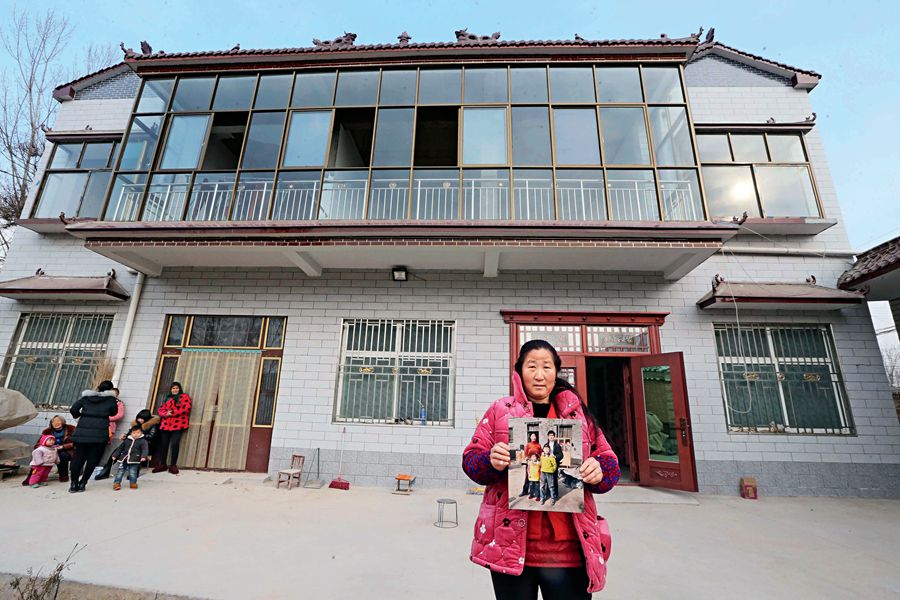LOCATED in the east of central China’s Henan Province, Lankao County has 13 towns, three residential communities, and 450 administrative villages under its jurisdiction. It has a total area of 1,116 square km and a total population of 850,000, among which 772,900 are from rural areas. The county was identified as a key county in the national development-oriented poverty alleviation campaign in 2002, and included in the contiguous destitute region of the Dabie Mountains in 2011.
In April 2014, a total of 77,350 needy people of 23,275 impoverished households in 115 poverty-stricken villages were identified countywide following due process. The incidence of poverty stood at 10 percent.

A farmer standing in front of her new two-story house in Lankao County of Henan Province, proud of the new change, on January 5, 2018.
From 2014 to 2016, Lankao County rolled out a targeted poverty alleviation campaign based on local conditions. The key to targeted poverty alleviation lies in taking targeted measures in terms of recipients, projects, and funding. Every impoverished household is guaranteed help, every village has designated officials to carry out poverty elimination measures, and the goals are met within the defined parameters. Guided by this strategy, a five-pronged initiative has been launched to eliminate poverty: developing local industries, relocating impoverished residents, offering compensation for ecological conservation, improving educational conditions, and providing a social safety net. The initiative aims to enable poor people to shake off poverty by improving local production capacity, increasing asset income, and upgrading medical services. In carrying out the strategy, solutions will be formulated for issues such as who needs assistance, who is responsible for the work, what assistance measures should be adopted, and how to implement an exit mechanism for those who have been lifted out of poverty.
As a consequence, the incidences of poverty in Lankao County had dropped to 1.27 percent by the end of 2016. In February, it was officially confirmed by the Henan provincial government that the county had risen out of poverty, the first such success in China. Lankao County’s triumph has greatly inspired other places of China.
Pivotal Guidance
Xi Jinping Thought on Socialism with Chinese Characteristics for a New Era, particularly the part on poverty elimination, is the guiding principle for implementing the development-oriented poverty alleviation campaign. The thought offers the theory, methodology, and practical guidance for the campaign.
In terms of the theory, the thought explicitly defines that winning the battle against poverty is of strategic significance. To accomplish the challenging task, poverty-stricken counties are required to prioritize poverty alleviation in social and economic development. The root cause and essence of poverty in rural areas must be made clear. The bottleneck problems that restrain local impoverished communities and households from ridding themselves of poverty and increasing their incomes should be reviewed based on local conditions. The dialectical relationships between poverty alleviation and work in other areas should be recognized. Deepening reform in other areas is aligned to the efforts in poverty alleviation, while the capacity for governance of the county government is improved through eradicating poverty.

A happy child is playing with a small toy windmill at a windmill exhibition held at the Zhangzhuang Primary School of Lankao County, Kaifeng City of Henan Province.
In terms of methodology, the thought stresses tailor-made measures for different regions according to local conditions. Competent government departments should ensure that policies and measures be carried out to the full extent faithfully. The strategy of targeted poverty alleviation has been carried out.
In terms of practical guidance, the thought makes it clear that the development is people-oriented, and that the focus of attention is the demand for poverty alleviation and development of the poverty-stricken communities. The policy support and external development opportunities shall be turned into tangible results of poverty reduction. Targeted measures are carried out to motivate the poor people to gain more confidence in their own ability to develop. The success of Lankao County in poverty alleviation validates the guiding principle of Xi Jinping’s thought on poverty eradication.
Advantages of China’s
Governance System in Poverty Alleviation
The state governance system for poverty alleviation under the leadership of the Communist Party of China (CPC) showcases distinctive political and institutional advantages. After three years of unremitting efforts from 2014 to 2016, Lankao County successfully alleviated poverty. During the three years, more than 70,000 people were raised out of poverty. Specific figures in 2014, 2015, and 2016 are 19,360 people in 5,063 households, 37,556 people in 10,843 households, and 12,675 people in 5,310 households respectively.
From a global perspective, it is a miracle that China could alleviate poverty on such a large scale within such a short period of time. Fundamentally fueling the miracle is China’s unique political and institutional advantages in terms of the governance system for poverty alleviation, driven by the strong leadership of the CPC.
From the day it was founded, the CPC has been pursuing its goal of national independence, state prosperity, and people’s wellbeing. Eliminating poverty, improving people’s livelihood, and attaining common prosperity are the essential requirements for the socialist cause under the CPC leadership. Development is for the people. It should be pursued by the people, and its outcomes should be shared by the people. This is the underlining tenet of the socialist cause with Chinese characteristics under the CPC leadership.
Since the 18th CPC National Congress in November 2012, the CPC Central Committee, with Xi as the core, has set lifting all impoverished people out of poverty as a target and indicator of completing the building of a moderately prosperous society in all respects.
Party secretaries at the provincial, prefectural, county, township, and village committee levels work in concert for the common goal of elimimating poverty. Governments and Party committees at all levels place poverty alleviation on top of their work agenda. The entire Party and nation are mobilized to offer support in terms of resources, manpower, policies, and institutions. Poverty alleviation has become a field attracting intensive political and public attention, many resource allocated, and lots of ground-breaking measures taken.
A raft of ground-breaking policies and institutional innovations offer both strong support to win the battle against poverty alleviation and experience for reforms of other areas. It further promotes China’s capacity for governance.
In addition, China has contributed much experience to the world in terms of regional efforts of poverty alleviation. For instance, the internationally accepted measurements of poverty, mainly through household surveys and participatory wealth assessment and the combination of the two methods, has an accuracy rate less than 65 percent, whereas the approach adopted in Lankao County in identifying impoverished people has an accuracy rate around 98 percent. This achievement is attributed to the reform of governance in poverty elimination, especially to what the working teams stationed in villages and primary Party committees have done. The strategy of targeted poverty alleviation is the solution China contributes to international poverty reduction and development.
System for Governance
Combining Policy with Reality
In the county-level poverty alleviation campaign, the targeted measures for poverty reduction are aligned with regional economic and social development and the demands of impoverished households and villages to form a system of governance.
The strategy of targeted poverty alleviation is ground-breaking in terms of both practice and theory from a global perspective. Globally, the complexity of poverty issues requires diverse and differentiating policy supplies. However, there is not much experience in this regard. The limited ones are gained from regional or specific anti-poverty intervention programs, with no systematic practices in state poverty alleviation being accumulated.
When China implemented the strategy of targeted poverty alleviation, ministries at the central level intensively rolled out a raft of policies and institutional reforms, offering strong support to local governments in planning pathways of eradicating poverty based on local conditions. In particular, centering on the capability of the government in supplying needed policies, China has adopted a working mechanism with the central authorities in charge of integrated planning, governments of provinces, autonomous regions, and municipalities taking overall responsibilities, and governments of cities, prefectures, and counties responsible for implementation. Each level shoulders its own responsibilities. In this way, China delegates the rights of decision making and resource to the county level and lower level, and motivates the vast impoverished population to actively participate in the efforts of poverty alleviation and development. This ensures the efficiency of policy implementation.
In Lankao County’s case, the decision-making rights for specific projects are further delegated to village administration bodies, and the authority for funding management is delegated to township-level governments. These reforms avoided mismatching the policies and better align them with poor people who have the willingness to develop. The strategy of targeted poverty alleviation and elimination has been adopted, with different measures tailor-made for different regions according to local conditions, to ensure the effect of poverty reduction.
Lankao County’s case of successful poverty alleviation offers experience for other poverty-stricken counties of China in winning the battle. It is expected to provide references for other developing countries on effectively tackling poverty issues.
HUANG CHENGWEI is director of the national publicity and education center for poverty alleviation under the State Council Leading Group Office of Poverty Alleviation and Development.

